Conosciamo la sensazione. Quel momento di sconforto in cui il vostro sito va giù e non avete idea del perché. È uno degli errori più comuni di WordPress, ma anche uno dei più misteriosi. Non vi dice cosa c’è che non va, ma solo che qualcosa è rotto.
La buona notizia? È quasi sempre risolvibile. Avendo aiutato innumerevoli personalizzati, abbiamo avuto a che fare con questo errore molto spesso.
In questa guida vi illustreremo i passaggi esatti per ripristinare il vostro sito e renderlo funzionante. Seguiteci e vedrete che tutto tornerà a funzionare in pochissimo tempo.
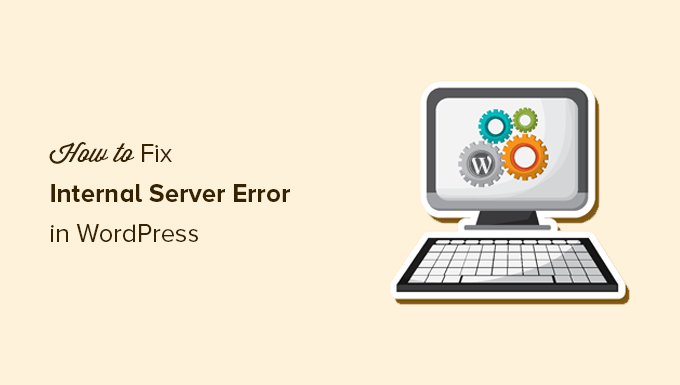
Ecco una rapida panoramica degli argomenti che tratteremo in questo articolo:
- What Is the 500 Internal Server Error?
- What Causes the Internal Server Error in WordPress?
- Fixing the 500 Internal Server Error in WordPress
- Clear WordPress and Browser Cache
- Checking for Corrupt .htaccess File
- Increasing the PHP Memory Limit
- Deactivate All WordPress Plugins
- Switch to a Default WordPress Theme
- Re-Uploading Core Files
- Enable Debug Logs in WordPress
- Ask Your Hosting Provider
- Video Tutorial
Che cos’è l’errore 500 Internal Server?
L’errore 500 Internal Server è come una porta bloccata senza chiave. Si sa che qualcosa non va, ma non c’è una nota che spieghi cosa è successo.
Questo errore non riguarda solo WordPress. Può apparire su qualsiasi sito web quando il server incontra un problema che non sa come gestire.
Il “500” nel messaggio è un codice di stato HTTP. Se lo cercate, troverete una definizione vaga:
“Il codice di risposta 500 Internal Server Error indica che il server ha incontrato una condizione inaspettata che gli ha impedito di soddisfare la richiesta”.
Non è molto utile, vero? È il modo in cui il server dice: “Si è rotto qualcosa, ma non sono sicuro di cosa”.
L’aspetto di questo errore dipende dalla configurazione dell’host e dal browser. Ecco un esempio di come appare su un server Apache:
Se il sito viene eseguito su Nginx, l’aspetto potrebbe essere leggermente diverso. Se Google Chrome non riesce a caricare una pagina di errore corretta, si vedrà qualcosa di simile:
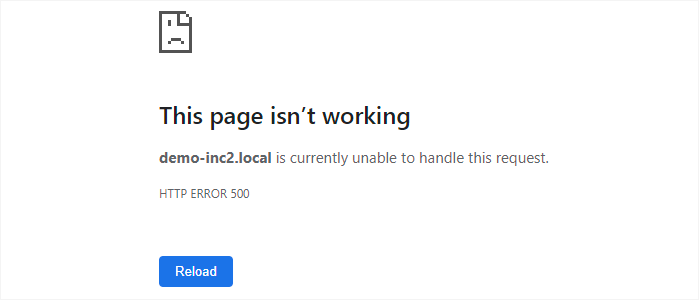
Per i principianti, questa situazione può risultare sconvolgente. Non c’è alcun messaggio che indichi cosa è andato storto o come correggerlo.
È come chiedere a un meccanico di correggere la vostra auto senza dirgli cosa è rotto. Dovranno controllare diverse parti fino a trovare il problema.
In base alla nostra esperienza, il modo migliore per correggere il problema è procedere passo dopo passo. Vi illustreremo le cause e le soluzioni più comuni per far sì che il vostro sito torni a funzionare.
Ottenete l’aiuto di un esperto in qualsiasi momento con il supporto WordPress on-demand!
Affrontare un errore interno del server può essere frustrante. Il nostro Supporto WordPress On-Demand è qui per aiutarvi a correggere i problemi tecnici in modo rapido ed efficace.
- Pagamento unico per l’assistenza on-demand di un esperto
- Tempi di consegna rapidi
- Disponibile 24 ore su 24, 7 giorni su 7
👉 O ttenete subito un supporto di emergenza per WordPress! 🛠️
Cosa causa l’errore interno del server in WordPress?
L’errore interno del server in WordPress è come un puzzle con pezzi mancanti. Sapete che qualcosa non va, ma il messaggio di errore non vi dice esattamente dove si trova il problema.
In base alla nostra esperienza, il colpevole più comune è un file .htaccess corrotto. A volte, si tratta di un plugin che si comporta male o di un tema che non funziona bene con la vostra configurazione.
Altre volte, il sito può colpire il limite di memoria PHP, causando il blocco di WordPress. Anche i file del core corrotti possono innescare questo errore, lasciandovi bloccati senza attenzione.
In alcuni casi, l’errore appare solo quando si cerca di accedere all’area di amministrazione di WordPress, mentre il resto del sito funziona correttamente. È come essere bloccati in casa propria mentre gli ospiti possono ancora entrare dalla porta sul retro.
Ciò che rende questo errore complicato è che di solito si verifica prima che WordPress possa essere caricato correttamente. Ciò significa che il server non può raccogliere abbastanza dettagli per spiegare cosa è andato storto.
Se volete dare un’occhiata più approfondita al funzionamento di WordPress dietro le quinte, consultate la nostra guida su come WordPress opera sotto il cofano.
Passiamo ora alla risoluzione dei problemi per ripristinare il funzionamento del sito.
Risolvere l’errore 500 Internal Server in WordPress
Prima di iniziare la risoluzione dei problemi, assicuratevi di avere a portata di mano un backup completo di WordPress del vostro sito web.
Se avete accesso all’area di amministrazione di WordPress, potete utilizzare un plugin di backup per WordPress per creare un backup completo del vostro sito web.
Per questo consigliamo di utilizzare Duplicator. Non solo vi aiuta a eseguire rapidamente il backup del vostro sito web, ma potete anche archiviare i vostri backup sul cloud e, soprattutto, potete ripristinare il vostro sito web dal backup.
D’altra parte, se non avete accesso all’area di amministrazione di WordPress, potete creare manualmente un backup di WordPress utilizzando phpMyAdmin e un client FTP.
In seguito, potete seguire i seguenti passaggi per risolvere il problema e risolvere l’errore del server interno sul vostro sito web.
Cancellare la cache di WordPress e del browser
I browser e i plugin di caching di WordPress possono talvolta memorizzare erroneamente una copia in cache di una pagina di errore.
Il modo più semplice per risolvere il problema è cancellare la cache del browser.
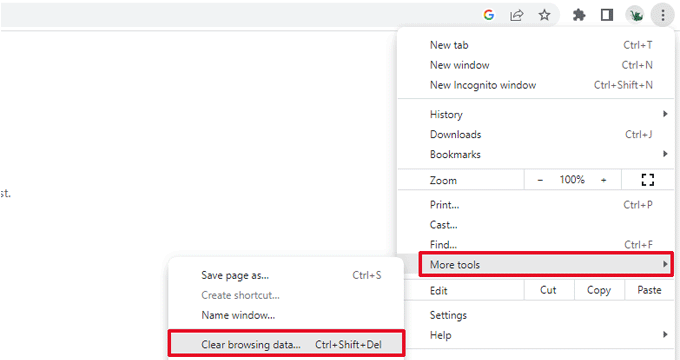
Dopodiché, se avete accesso all’area di amministrazione di WordPress del vostro sito web, potete svuotare la cache di WordPress visitando la pagina delle impostazioni del vostro plugin di caching.
Per maggiori dettagli, consultate il nostro tutorial su come cancellare la cache di WordPress.
Verifica della presenza di un file .htaccess corrotto
Il file .htaccess è un file di configurazione del server utilizzato da WordPress per impostare i reindirizzamenti.
Una delle cause più comuni di errore interno del server è il file .htaccess corrotto.
Il modo più semplice per correggere questo problema è semplicemente visitare la pagina Impostazioni ” Permalinks nell’area di amministrazione di WordPress e poi fare clic sul pulsante “Salva modifiche” senza apportare alcun cambiamento.
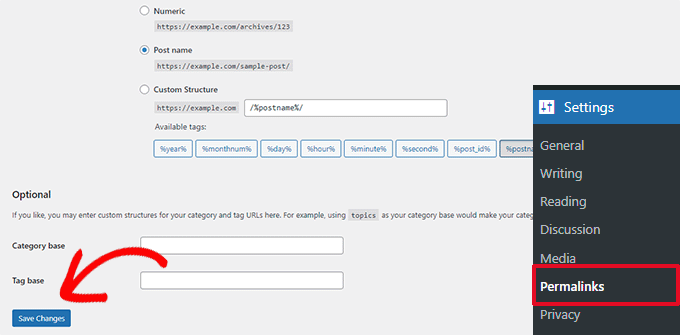
WordPress cercherà ora di aggiornare il file .htaccess o di generarne uno nuovo. Ora è possibile visitare il sito web per verificare se l’errore del server interno è stato corretto.
Se l’errore è ancora visibile, è necessario assicurarsi che WordPress sia stato in grado di generare o scrivere sul file .htaccess.
A volte, a causa delle autorizzazioni di file e directory, WordPress potrebbe non essere in grado di creare o scrivere sul file .htaccess.
Ora potete provare a sostituire il file .htaccess manualmente. Per prima cosa, dovete accedere al vostro sito web utilizzando l’FTP o l’applicazione File Manager nel pannello di controllo del vostro account di hosting.
Successivamente, è necessario rinominare ilfile .htaccess principale in qualcosa come .htaccess_old. Questo vi consente di mantenere il file come backup, ma WordPress non lo riconoscerà.
Per rinominare il file .htaccess, dovrete accedere al vostro sito utilizzando l’FTP o l’applicazione File Manager nel cruscotto del vostro account di hosting.
Una volta collegati, il file .htaccess si troverà nella stessa directory in cui sono presenti cartelle come wp-content, wp-admin e wp-includes.
È sufficiente fare clic con il tasto destro del mouse sul file .htaccess e rinominarlo in .htaccess_old.
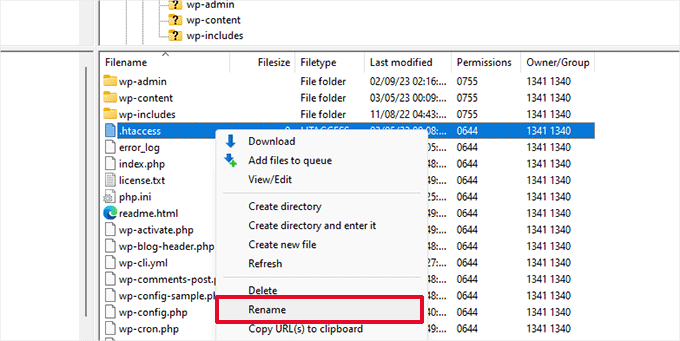
Successivamente, è necessario creare un nuovo file .htaccess.
All’interno della cartella principale del sito, fare clic con il tasto destro del mouse e selezionare l’opzione “Crea nuovo file” nel client FTP o nell’applicazione File Manager.
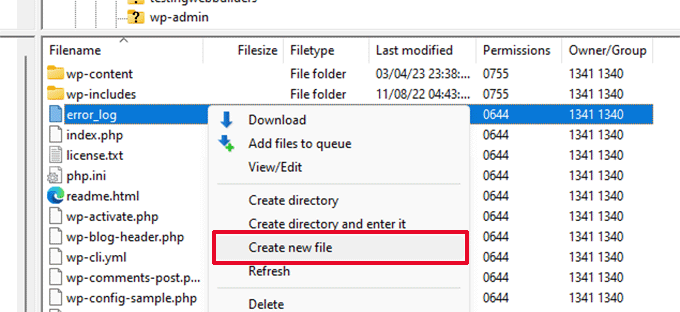
Nominate questo nuovo file .htaccess e fate clic su “OK” per salvarlo.
Ora, questo file .htaccess è attualmente vuoto ed è necessario aggiungervi le regole di riscrittura predefinite di WordPress.
È sufficiente fare clic con il tasto destro del mouse sul file e selezionare “Visualizza/Modifica” nel client FTP o nell’applicazione File Manager.
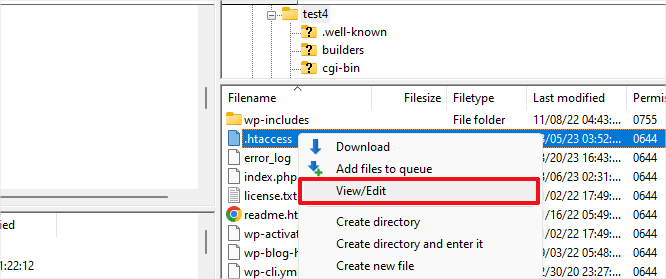
Il file vuoto si aprirà in un editor di testo semplice come Notepad o TextEdit.
A questo punto, è necessario copiare e incollare il seguente codice al suo interno:
1 2 3 4 5 6 7 8 9 10 | # BEGIN WordPress<IfModule mod_rewrite.c>RewriteEngine OnRewriteBase /RewriteRule ^index.php$ - [L]RewriteCond %{REQUEST_FILENAME} !-fRewriteCond %{REQUEST_FILENAME} !-dRewriteRule . /index.php [L]</IfModule># END WordPress |
Questo codice è il set di regole predefinito utilizzato da WordPress. Non dimenticate di salvare le modifiche e di caricare il file sul server.
Ora è possibile visitare il sito web per verificare se l’errore del server interno è stato risolto.
In caso affermativo, allora datevi una pacca sulla spalla perché avete risolto l’errore interno del server.
Importante: prima di procedere con altre operazioni, assicuratevi di andare alla pagina Impostazioni ” Permalinks nell ‘area di amministrazione di WordPress e di fare clic sul pulsante Salva senza apportare alcuna modifica. In questo modo il file .htaccess verrà rigenerato con regole di riscrittura adeguate per garantire che le pagine dei vostri post non restituiscano un errore 404.
Se la soluzione per verificare la presenza di un file .htaccess corrotto non ha funzionato, allora dovete continuare a leggere questo articolo.
Aumentare il limite di memoria di PHP
A volte, l’errore interno del server può verificarsi se uno script consuma tutto il limite di memoria di PHP.
Il modo più semplice per aumentare il limite di memoria di PHP è modificare il file wp-config.php. Se siete principianti, fate attenzione a questa operazione. Seguite attentamente queste istruzioni, perché anche piccoli errori nei file principali di WordPress possono danneggiare il vostro sito.
Per iniziare, è sufficiente collegarsi al proprio sito web WordPress utilizzando un client FTP o l’applicazione File Manager nel pannello di controllo del proprio account di hosting.
Il file wp-config.php si trova nella cartella principale del vostro sito web. Fate clic con il tasto destro del mouse su di esso e selezionate “Scarica”. In questo modo vi assicurerete di avere un file di backup nel caso in cui qualcosa vada storto.
Una volta salvato, è possibile fare clic con il pulsante destro del mouse e selezionare “Visualizza/Modifica”.
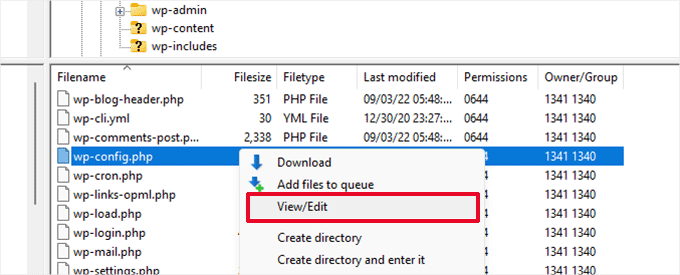
All’interno del file wp-config.php, è necessario aggiungere il seguente codice appena sopra la riga che recita: “Questo è tutto, smettete di modificare! Buona pubblicazione”:
1 | define( 'WP_MEMORY_LIMIT', '256M' ); |
Per maggiori dettagli, consultate il nostro tutorial su come aumentare il limite di memoria PHP in WordPress.
Nota: se 256M non risolve il problema, provare ad aumentare a 512M.
Se l’errore del server interno viene visualizzato solo quando si tenta di accedere all’amministrazione di WordPress o di caricare un’immagine in wp-admin, allora è necessario aumentare il limite di memoria seguendo questi passaggi:
- Creare un file di testo vuoto sul computer e chiamarlo php.ini.
- Incollare questo codice: memoria=256MB
- Salvare il file
- Caricate il file nella cartella /wp-admin/ tramite FTP.
Se l’aumento del limite di memoria ha risolto il problema, allora il problema è stato risolto solo temporaneamente. È ancora necessario trovare la causa che sta esaurendo il limite di memoria.
Potrebbe trattarsi di un plugin mal codificato o anche di una funzione del tema. Vi consigliamo vivamente di chiedere alla vostra società di web hosting WordPress di esaminare i log del server per aiutarvi a trovare la diagnostica esatta.
Se l’aumento del limite di memoria di PHP non ha corretto il problema, è necessario risolvere altri problemi.
Disattivare tutti i plugin di WordPress
Se nessuna delle soluzioni precedenti ha funzionato, è molto probabile che l’errore sia causato da un plugin specifico installato sul vostro sito web.
È anche possibile che si tratti di una combinazione di plugin che non funzionano bene tra loro.
Se potete accedere all’area di amministrazione di WordPress del vostro sito web, potete semplicemente andare alla pagina dei plugin e disattivare tutti i plugin di WordPress.
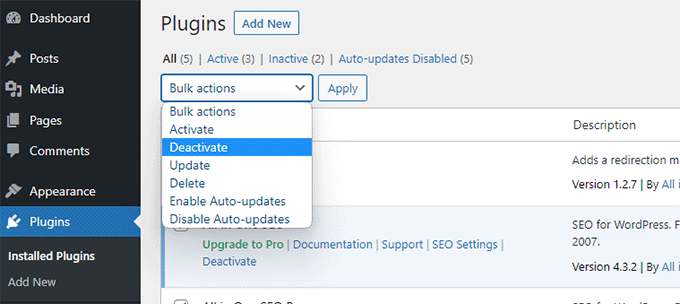
Tuttavia, se non riuscite ad accedere all’area di amministrazione di WordPress, potete disattivare tutti i plugin di WordPress utilizzando l’FTP.
È sufficiente collegarsi al proprio sito Web WordPress utilizzando un client FTP o l’applicazione di gestione dei file nel pannello di controllo del proprio account di hosting.
Una volta collegati, navigare nella cartella /wp-content/ e rinominare la cartella plugins in plugins.deactivated.
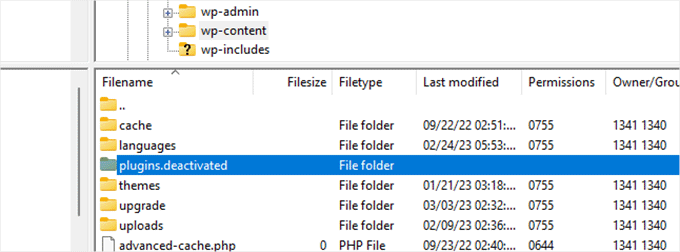
WordPress cerca i plugin nella cartella plugins. Se la cartella plugins non viene trovata, disattiverà automaticamente tutti i plugin.
Ora potete provare a visitare il vostro sito web per verificare se questo ha risolto l’errore del server interno sul vostro sito web.
Per ripristinare tutti i plugin, è sufficiente rinominare la cartella ‘plugins.deactivated’ in plugins.
I plugin verranno ripristinati, ma saranno ancora disattivati.
Ora è possibile attivare i singoli plugin e visitare il sito web per capire quale plugin sta causando l’errore interno del server.
Per maggiori dettagli, consultate la nostra guida su come disattivare tutti i plugin di WordPress senza wp-admin.
Se la disattivazione di tutti i plugin non ha risolto l’errore interno del server sul vostro sito web, continuate a leggere.
Passare a un tema WordPress predefinito
Una possibile causa dell’errore del server interno potrebbe essere un codice del tema di WordPress.
Per determinare se questo è il caso, è necessario cambiare il tema con un tema predefinito di WordPress.
Se avete accesso all’area di amministrazione di WordPress, andate alla pagina Aspetto ” Temi. Se è già installato un tema predefinito, è sufficiente fare clic sul pulsante Attiva per cambiare il tema.
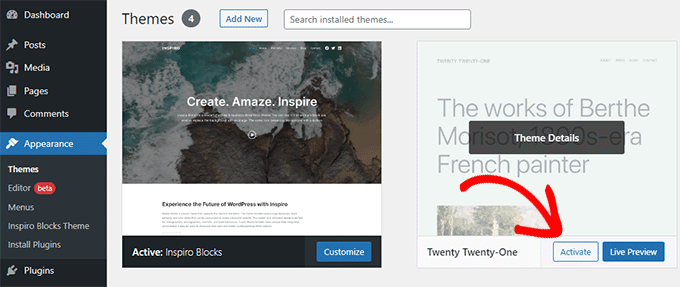
Se non avete installato un tema predefinito, potete fare clic sul pulsante “Aggiungi nuovo” in alto e installare un tema predefinito (Twenty Twenty-Three, Twenty Twenty-Two e così via).
Se non avete accesso all’area di amministrazione di WordPress, potete comunque passare a un tema predefinito.
È sufficiente collegarsi al proprio sito web WordPress utilizzando un client FTP e navigare nella cartella /wp-content/.
Fare clic con il pulsante destro del mouse per selezionare la cartella dei temi e scaricarla sul computer come backup.
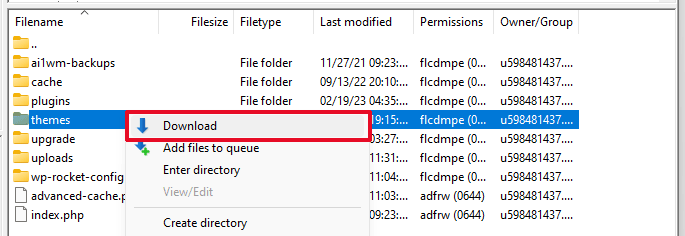
Successivamente, è necessario eliminare la cartella themes dal sito web. Una volta eliminata, creare una nuova cartella themes.
La nuova cartella dei temi sarà completamente vuota, il che significa che al momento non è stato installato alcun tema di WordPress.
Successivamente, è necessario visitare la directory dei temi di WordPress e scaricare un tema predefinito di WordPress sul computer.
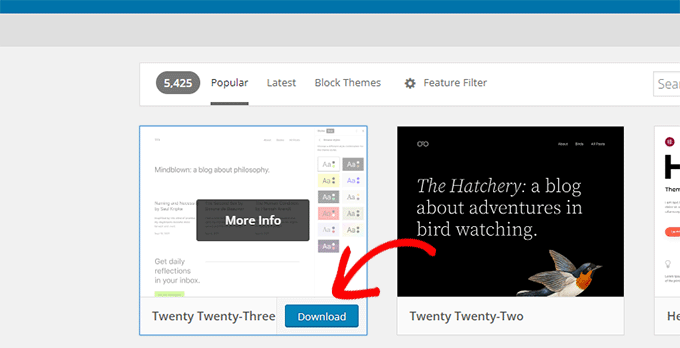
Il vostro browser scaricherà quindi il tema come file zip sul vostro computer.
Individuare il file sul computer e decomprimerlo. Gli utenti di Windows possono decomprimere il file facendo clic con il pulsante destro del mouse e selezionando “Estrai tutto”. Gli utenti Mac possono fare doppio clic sul file zip per estrarlo.
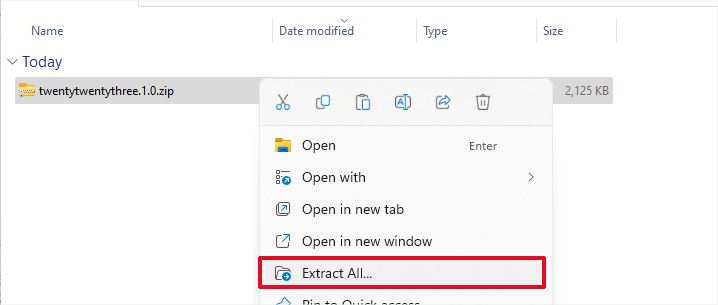
Ora vedrete una cartella contenente il vostro tema di WordPress.
Passare nuovamente al client FTP o al File Manager e caricare questa cartella nella cartella vuota dei temi.
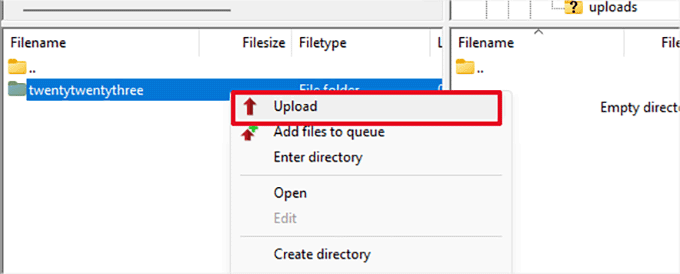
Una volta caricato, WordPress inizierà automaticamente a utilizzare il tema predefinito.
Ora è possibile visitare il sito web per verificare se l’errore del server interno è stato risolto.
Se non funziona, potete ricaricare i vostri temi WordPress dal backup o tornare al tema che stavate usando.
Non preoccupatevi. Ci sono ancora alcune cose che potete fare per risolvere l’errore.
Ricaricamento dei file del nucleo
Se le opzioni dei plugin e dei temi non hanno risolto l’errore interno del server, è opportuno ricaricare le cartelle /wp-admin/ e /wp-includes/ da una nuova installazione di WordPress.
Questa operazione NON rimuove le informazioni, ma può risolvere il problema nel caso in cui un file sia danneggiato.
Per prima cosa, è necessario visitare il sito web WordPress.org e fare clic sul pulsante “Download”.
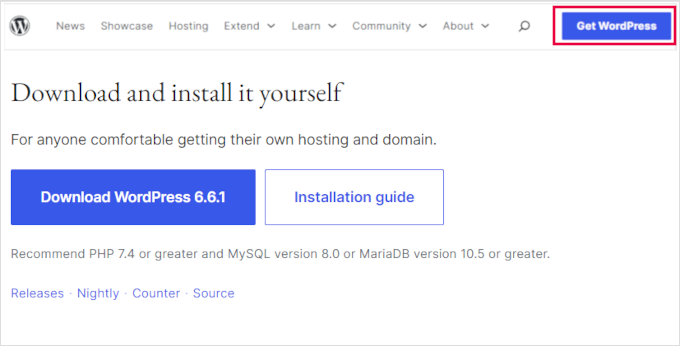
Questo scaricherà il file zip di WordPress sul vostro computer.
Procedere con l’estrazione del file zip. Al suo interno troverete una cartella wordpress.

Successivamente, è necessario collegarsi al proprio sito web WordPress utilizzando un client FTP.
Una volta collegati, accedere alla cartella principale del sito web. È la cartella che contiene le cartelle wp-admin, wp-includes e wp-content.
Nella colonna di sinistra, aprite la cartella WordPress sul vostro computer.
Ora è necessario selezionare tutti i file presenti nella cartella di wordpress e caricarli sul sito web.
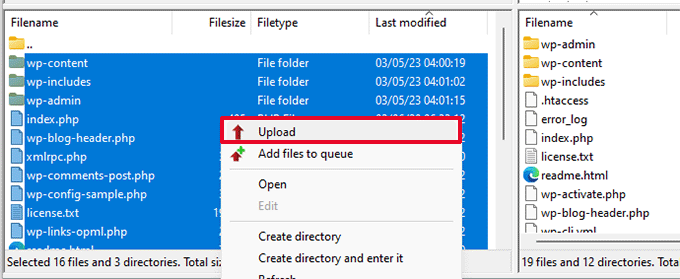
Il vostro client FTP trasferirà ora queste cartelle sul vostro server.
Verrà chiesto se si desidera sovrascrivere i file. Selezionare “Sovrascrivi”, quindi selezionare “Usa sempre questa azione” e selezionare la casella di controllo “Applica solo alla coda corrente”.
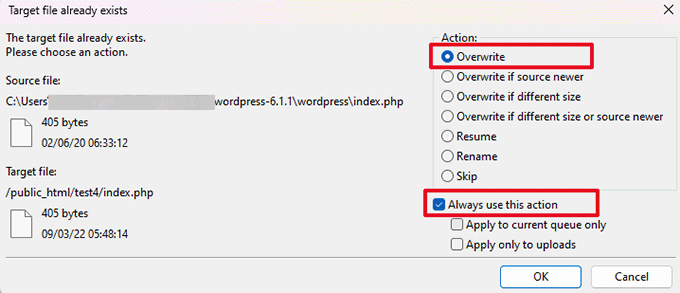
Il vostro client FTP sostituirà ora i vecchi file di WordPress con nuove copie fresche.
Se i file di WordPress sono stati danneggiati, questo passaggio risolverà l’errore interno del server.
Abilitare i log di debug in WordPress
WordPress è dotato di un sistema integrato per mantenere i log per il debug.
È possibile attivarlo utilizzando il plugin WP Debugging. Per maggiori dettagli, consultate la nostra guida su come installare un plugin di WordPress.
Una volta attivato, il plugin attiva i log di debug sul vostro sito web WordPress.
Se non avete accesso all’area di amministrazione del vostro sito WordPress, potete attivare il debug aggiungendo il seguente codice al file wp-config.php:
1 2 | define( 'WP_DEBUG', true);define( 'WP_DEBUG_LOG', true); |
Una volta attivati i log di debug, è possibile visualizzarli utilizzando un client FTP e navigando alla cartella /wp-content/.
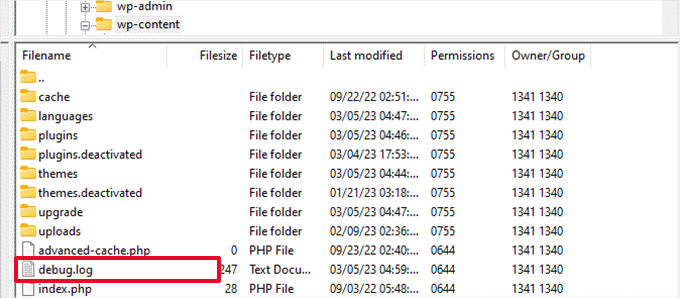
Il file di log di debug può essere aperto in un editor di testo e mostrerà un elenco di errori e avvisi che si verificano sul sito web.
Alcuni errori e avvisi possono essere incidenti innocui che non devono essere risolti. Tuttavia, se il vostro sito web presenta un errore interno del server, questi possono indicarvi la giusta direzione.
Chiedete al vostro fornitore di hosting
Se tutti i metodi non riescono a risolvere l’errore interno del server sul vostro sito web, allora è il momento di chiedere aiuto.
Contattare il team di assistenza del web hosting, che sarà in grado di controllare i registri del server e individuare la causa principale dell’errore.
Se volete continuare a risolvere i problemi da soli, consultate la nostra guida definitiva alla risoluzione dei problemi di WordPress per i principianti.
Video tutorial
Se questo articolo vi è piaciuto, iscrivetevi al nostro canale YouTube per le esercitazioni video su WordPress. Potete trovarci anche su Twitter e Facebook.





Ryan
I get the same Internal Server Error happening every couple of weeks now.
Each time it’s an issue with the .htaccess file, it’s an easy fix to get the site up and running thanks to the info you provided above but is there anything I can do that will prevent the error re-occurring?
Thanks.
carl
Thanks dude, you saved my beans and saved me from some real hassle. Super Kudos
Anil
Any advice for intermittent 500 errors?
WHITEFEATHER HUNTER
I tried renaming the htaccess file to htaccess_old like you said, and it disappeared! Now I get 404 errors every time I try to load the website’s various pages.
My original problem was indeed the plugins – deactivating them brought my website back online. However, NOW I have this 404 problem.
Also, I cannot find a Settings option in FileZilla – can you please help?
Thanks!
Chad Warren
The reason you are receiving 404 errors is because you have renamed your .htaccess file The .htaccess file contains the rewrite code to make your links pretty. ie: http://www.example.com/about instead of http://www.example.com/?p=259
The simplest way to correct this is to log into the WP admin and go to Settings >> Permalinks Make sure you have the proper permalink option selected and then Save. This will recreate the the proper rewrite peramaters within .htaccess
Previsha
Thank you so much, Changing the .htaccess file worked.
Norman Fellows
Hi Editorial Staff!
Checking for the corrupt .htaccess file solution worked for me. Thank you.
I had been doing a lot of work on the site including updating Jetpack. Not sure what the culprit was but I was completely locked out…
Matthew
Pretty useful! Good job Syed.
aiyeboy
thanks but whenever i rename the htaccess the site comes up and goes down after 1 minute again and this as been keeping my website offline for days now….helpppp
WPBeginner Support
Why would you rename htaccess file? Delete any .htaccess file you have renamed including the original .htaccess file.
Admin
aiyeboy
you mean i should delete my htaccess file , but it automatically comes back.
WPBeginner Support
Yes it does, if your .htaccess file had some problem then deleting it should have solved it.
Owolabi
You Guys are great ! I always find solution to my problems here. once again tank you and keep the good work up.
Cheers!
pushkar
Nothing of the above worked. It seems the problem was with my wordpress Theme. I changed to another theme and the website is back to normal. This link shows how to change the theme without a working admin http://wordpress.shadowlantern.com/change-wordpress-theme-in-phpmyadmin/
WPBeginner Support
You can also change your theme by deleting all themes and only leaving the theme that you want to use in /wp-content/themes directory.
Admin
viksit singh
Really work’s thanks dude
It’s good Nice post Having a great knowledge about that…
Please Help i want a hosting service which is cheep giv me domain and Support
Thanks
Jayson T Cote
I wanted to add another situation that may cause Internal Server errors and can be easily remedied.
Check your php.ini file usually located in your root directory on your web hosting server.
I recently updated our server from PHP version 5.3.x to 5.4.x The update changed a few PHP options which were set differently in the local php.ini file. We made the same changes to the website’s local php.ini file as we did on the server and eliminated the Internal Server error.
Take caution, you can try renaming the php.ini file (php.ini.old) and reload your website to see if it makes a difference. Looking at the servers error logs will determine the exact PHP option in question that will need to be edited in your local php.ini file.
Bill Cruz
Thank you based god! renaming my .htaccess file and forcing a new one to be created resolved my blank webpage! I reset my mySQL database password, and updated the password on the wp-config.php file, but that still didn’t fix it, but this method did. Thanks.
Mikkel Lindblom
Thank you! Allways remember to check the .htaccess file
Mert Can
Hi,
I would like to ask you, how can I edit this error file (Internal Server Error)? Because it’s showing there my e-mail address. I am using linux Debian 7.
Thanks,
Best Regards,
Vyacheslav
Thank you for such a good article. This set of fixes is really handy to keep them all at fingertips.
My problem was the .htaccess file, but not the one in the root folder. It was rather the one in my /wp-admin folder. It came about that I protected /wp-admin folder with a password by means of host provider panel. It created the .htaccess file inside my /wp-admin folder. I also added some code into the file too.
Later I turned such a password protection of the folder off, so the code added by host provider panel itself was taken from the .htaccess file automatically. Meanwhile the code added by me still remained in the file. This piece of code caused the problem leading to Internal Server Error 500.
I just removed the .htaccess file due to its lack of necessity and it did the trick.
Vijay Sharma
Yes, it works for me to get the idea,
Solutions process I did
1. Define Php memory limit in “wp-config.php”
2. Deactivate all plugins
3. Update permalinks structure
4. Activate plugin one by one
NatalieDawn
Hey,
I have loads of problems with 503 error. My host told me it’s a problem with index.php file. Don’t know, how to solve it, HELP PLEASE! (I’m really desperate now ).
).
Asha Singh
Can i fix by uploading manual file or need to change any hosting file of ny site . because it has same issue several times at my end.
Thanks for info.
WPBeginner Support
Yes you can try uploading fresh copies of files to your server overwriting any existing files you might have. Please backup first.
Admin
Paul
yes I went through all the steps and as always my luck get the hardest, reinstalled via ftp job done!
Piers
Hooray, the .htaccess thing did the trick. Thanks so much for the valuable tips.
Yogesh
goooooooooooood…….Thanks bro
illahi
very informatice article i love it
Paul
None of the above worked for me – however, that’s because of what was causing my issue – so I thought they wouldn’t but tried them anyway.
However, I’ve dealt with heaps of WordPress sites so wasn’t too worried when I came across the issue.
For me, the error appeared when trying to access admin (the site itself loads) and it wasn’t the hosting as it was a site on my temp hosting platform and all other sites are fine.
The solution though is very simple (for what caused my issue),
I knew it happened just after changing the permalink structure, and I had accidently clicked the ‘Custom Structure’. (I was meant to use one of the others for this site). In my case this didn’t carry over to the htaccess file and removing the file didn’t work either.
Fix:
You’ll need access to phpMyAdmin. Locate the database used for your install. Locate the wp_options table and find the permalink_structure row (around 30 or so). You can edit the permalink there back to one of the others.
Next, edit the htaccess file with this to include the proper rewrite rules:
# BEGIN WordPress
RewriteEngine On
RewriteBase /
RewriteRule ^index\.php$ – [L]
RewriteCond %{REQUEST_FILENAME} !-f
RewriteCond %{REQUEST_FILENAME} !-d
RewriteRule . /index.php [L]
# END WordPress
After that clear your browser cache and refresh – also try getting in through a different browser.
This is one of many solutions – it works for me to reset permalinks.
khandy
Thank you!
The php.ini file saved me.
Have had this problem since introducing random header images to the Graphene theme. If this happens again later today (before I’ve got the error logs from my host) will this work again or do I need to up the number?
Bobbie Blakely
Hi Thank you for all of your help. I have a 500error, internal server error. I changed the plugin name to plugin.deactivate, that didn’t change the error. I tried to change the name for .htaccess file but it says that I can’t because the folder is empty. I have been having trouble for three days. I fix one thing and I get another error. Today I uploaded my wp backup files via FTP. Upon completion is when I got the 500 error. I would be grateful for any help. Thank you
Bobbie
WPBeginner Support
Bobbie, try this. Download your /wp-content/plugins and /wp-content/themes folders to your computer. Then delete the ones from your server and create new empty directories with the same names. From your website’s root directory delete your .htaccess file (You can later regenerate it again from settings -> permalinks.
Admin
poemaderoca
I disabled my plugins but didn’t help so decided to rename .htaccess file and this solved my problem. Thanks for the tutorial.
Stuart
Thank you. A real saver!! A corrupted .htaccess file was the answer
chris
seriously quick and painless! thanks!
Sascha
Thanks for this. Helped me a lot!
Tim
Thank you!. It was the .htaccess file that was the issue! The issue occurred after installing and activating the eCommerce shop.
I have not got a clue how renaming that file fixed it but it did! So thanks again!
Anton
Renaming the file .htaccess file worked. Thank you!!!!
Noerila
Wow.. great article !
its works for me..
thanks, man..
Chris
Thanks so much! Changed the name of the htaccess file and my 500 error disappeared!
Erik von Werlhof
Whew!
Had this problem pop up last night and thought I would be toast! I tried the solution as outlined above and it worked!
Much thanks,
Erik
Hossam
unfortunately NONE of the above worked for me, but I think I’ve another issue related to this O.o
my problem is: my website worked fine, but when trying to edit any plugin’s settings or adding a new data to it, here is the “page not found” appears to me!! NOTE that I’m using %postname% as permalinks, and when changed it to “default” then try again to edit any plugin, here is ” Internal Server Error” appears O.o
I’m confused, please help
thanks in advance
sebastian okelly
Excellent article. This is a really useful site for those who get lost in the Codex. Thanks.
Remington Phillips
Thank you! For me changing .htaccess to “.htaccess_old” worked.
Deckey
Hi,
I still have the problem with the Internal Error.
I’ve tried all your ways (PHPmemory, htaccess, plugins deactivated…) And still doesn’t work.
If I change htaccess, the Internal Error change message and there’s another:
“Not Found
The requested URL /about/ was not found on this server.
Additionally, a 404 Not Found error was encountered while trying to use an ErrorDocument to handle the request.
Apache Server at http://www.gdbautomotive.com Port 80″
How can I do?
Maybe is better for me to do the website again from the start?
Because I’ve done the passage from localhost to remote server…
Maybe if I restart everything immediately on the web is better and it will work?
I’m quiet desperate and I don’t know how to do other things….
Thank you so much,
Deckey
WPBeginner Support
Before doing that try the last option mentioned in the article and ask your web host for support.
Admin
Krishanu Choudhury
Hello i run A blog which has preety good alexa ranking.i currently use MArkabihost for hosting my website and use wordpress script.now i have decided to move to better hosting service so i would you suggest you a good hosting service whcih is cheap and better And i want to know the ways to backup from Markabi to current hosting service
WPBeginner Support
Take a look at our hosting guide, how to choose the best WordPress hosting.
Admin
payal
how can i solve error in which the web page show that contact adminstrator?
Terhie
Hi, I’d like to thank you for your help. There are many pages with ‘error 505’ solving, but yours was clear and simple, and that’s what makes the difference.
My problem was just a little bit different. Internal Server Error appeared only when I tried to get to admin panel via Android WordPress application. Everything else was fine, and I could login to admin panel via browser no matter what OS or browser I used.
My hosting provider declined existence of any logs (yeah…), but thanks to your site I’ve found that one of my plugins cause this error.
Thanks a lot!
Walter
Hi. When i delete my access file my pages works. But then i refreshing my permalinks causes it again. So it is a cycle.
WPBeginner Support
There can be other reasons like for example your WordPress Hosting provider may not have mod_rewrite enabled (unlikely but not unheard of). If you are using a custom permalink structure defined by using your own tags try switching to month or date based and see if this resolves the problem. If it does, then this means that your custom tags were not in correct format. You can also try creating your .htaccess file manually. It should have this code only:
# BEGIN WordPress<IfModule mod_rewrite.c>
RewriteEngine On
RewriteBase /
RewriteRule ^index\.php$ - [L]
RewriteCond %{REQUEST_FILENAME} !-f
RewriteCond %{REQUEST_FILENAME} !-d
RewriteRule . /index.php [L]
</IfModule>
# END WordPress
Admin
Nicole
PHP memory increase worked. THANK YOU!
harryjkt
Hi,
i got correct solution from your site..
Thanks
Trent
Ok, so this one is not one this page yet! I was moving from one cPanel Server to another cPanel Server. I did use the /scripts/pkgacct $user as well as the transfer accounts options, both gave me Internal Error 500. After several hours I found this page and tried everything except reinstalling WordPress.
Well the culprit was actually the PHP.INI file. I downloaded the php source binaries and uploaded the php.ini-production file. I then deleted the php.ini file and renamed the php.ini-production to php.ini. Everything worked well.
Hopefully it helps!
Dave
Thanks…. it was a memory issue for me. I was only getting the error though on one plug-in. The rest of the site was working fine. Might put that in there somewhere too as it might be useful for somebody else.
Thanks.
Puneinvest
Hi,
Nice Article. I follow all process. But problem not solve.
When I check my error log –
PHP Parse error: syntax error, unexpected ‘}’ in …/themes/techmaish/index.php on line 1
Just replace index.php to server
Now my problem solve.
Again thanks Your post is great
Christopher
I love sites like this. Thank you for a clear, concise, and well laid out tutorial/troubleshooting post. Well done Sir.
Daniela
THANK YOU!!! I made all the changes, htaccess, increased memory size…
Then called the hosting company… and I was told that ALL my sites were infected by a virus!!!
So I went back to this post and did this one step I did not do which was deactivating all plugins. That did the trick!
It was Jetpack …..
Sam
Thanks it was .htaccess file doing that all. The file was uploaded with my site mistakenly Thanks again.